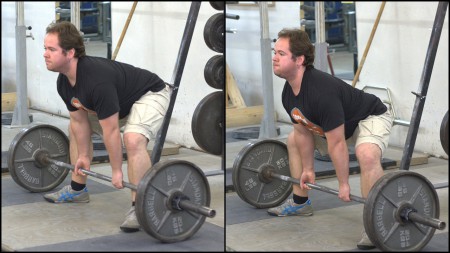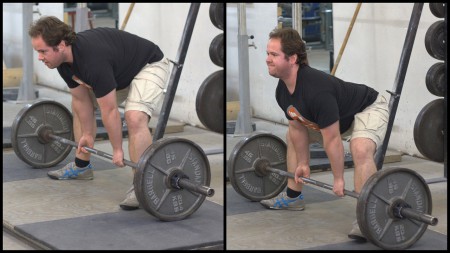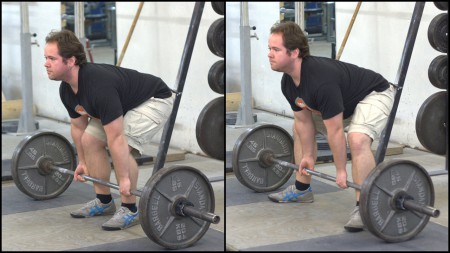We’ve had some talk lately about sumo deadlifts. Some of you are still of the mindset that “only conventional deads are ‘real’!” That’s fine. When you finally come around and try these, the rest of us will already be well-versed with them.
Our model today is one of my Vintage Strong lifters, RoryT. He’s a 181-198 powerlifter who is built to squat and bench, but not to pull. Before I took over his training, he had frustratingly beat his dead against the 450lb brick wall for about a year or so. We transitioned him to sumo pulling about a year ago (along with a wide-stanced squat to compliment it) and he ended up pulling 500lbs for the first time as my birthday present – along with recently getting his squat to 520×2. At our gym Push/Pull meet June 1st, I expect him to pull around 525 or so, which will be a nice PR for him. He should get 550 by November, his next meet.
The first thing most people screw up on any kind of deadlifts is the width of their grip. Your arms need to hang straight down from your shoulders. Any angle in, or more likely, out, makes you do more work – it sets you up in a more awkward starting position and makes the distance you have to pull longer. This is true for conventional pullers, and a very common mistake, but is even more troublesome with sumo deads, because if you grip the bar too wide, your hands get even more in the way of the movement than normal.
The second thing everyone needs to pay attention to is stance-width. When you first transition to sumo pulls, work your feet out to a wider stance SLOWLY, over several sessions, and stretch – a lot. Your hips will thank you. At first, getting your feet just outside of your hands will be fine. As you become mobile enough, going wider will mean a shorter stroke and a stronger lockout, at the expense of increasing the difficulty of breaking the bar off the floor. We’ll call this the “Narrow Sumo.” Don’t expect to be dramatically stronger at narrow sumo than conventional – it’s essentially going to put your levers in the same position, as you can see in the pic.
Eventually, you’ll be able to comfortably slide your feet out several more inches per side, which will allow you to shorten the ROM of the movement. We’ll call this the “Wide Sumo” because we’re brilliantly original. Wide sumo does not have to mean your feet are touching the plates, OK? It does mean that you’ll be able to have a slightly more vertical back-angle, which is a great benefit for those of you like Rory who have a relatively long torso for your height, and/or shorter arms – which is basically the perfect build to go ahead and run with sumo.

On the right is Rory’s slighty wider sumo stance (see the increased distance between his hands and shins?) Note the more advantageous back angle (admittedly, he’s more arched and set up to pull, too). It’s not a drastic-wide stance.
Your grip and stance width are the most basic parts of learning sumo, so once you have them correct, it’s time to set up for a pull. I’m going to tell you to get your feet UNDER the bar as Rory has done in the pics above. You are literally going to have the bar touching your shins. Most people set up too far away from the bar, and as a result, have a forward-angled-shin. The coaching cue here is “straight shins,” which is silly, because your shin can’t not be straight. It’s short for straight up and down, or vertical. Think STRAIGHT SHINS, and make them as vertical as possible.

The left is how it SHOULD look. The right is how it probably looks when you first try sumo. Note the angles of the shins and arms.
Get your feet under the bar and grab the bar at the appropriate width. Chances are it feels awkward as hell if you’re doing it correctly. Good. You want to get your center of mass as far behind the bar as you can without falling over. The cue here is STRAIGHT ARMS. You want to try and get your arms much more vertical than you’re probably used to. You could probably condense both of these cues and just yell “BE STRAIGHT” to your lifter, but that might raise some eyebrows at your gym and make you look like a jackass.
When you’re in the correct starting position, and you feel like you’re about to fall on your ass, it’s time to start the pull. As with the regular dead, you must set your lower back, flex your posterior chain, and get to work. It’s even more important on sumo, so get it right. Getting your lumbar flexed and solid before the pull is KEY. If you have problems locking out a sumo, you’re probably not setting your back well enough. You’ll also think “chest up,” though again, that’s not a literal cue – it simple means to get your upper back tensed as well. If your nipples are pointed at the bar, you’re gonna have a bad time.

SET YOUR BACK! Or you will die. The left might feel easier when getting the bar off the floor, but it won’t go anywhere after that. The right will mean a smooth 3-white-light PR. Do it.
Initiate the pull by squeezing the bar off the floor using your glutes and hams, which should be tensed as soon as you touch the bar. Carry this momentum as hard and as quickly as you can all the way to lockout. Think about shoving your hips FORWARD into the bar all the way until lockout, and don’t re-bend your knees at the top. Yes, we use the “hips!” cue. Yes, it makes us sound douchey, like a multiply gorilla. No, we don’t care. Always yell “OH YEAH!” when the hips are truly engaged. Trust me.
Another way to look at this is to think about “pulling back” on the bar. Both cues basically accomplish the same thing, but see which resonates best for you, and stick with it. Your weight should always be concentrated on your heels for a sumo pull. If you’re coming up on your toes, fix it.
A note on footwear: You should sumo pull in a flat-soled shoe. For what I hope are obvious reasons, don’t use your heeled Olympic shoes. Wrestling shoes are the best bet, but IPF-approved slippers are a $10 option if you’re cheap. I prefer to pull in socks at my gym, because it’s easy. Chucks are OK, but still have a bit of a platform and that could cost you a PR. Rory squats and pulls in the shoes pictured in the gym, but uses Titan slippers at meets.
Hopefully this helps you figure out how to sumo. Ask any questions you have below. Once you get your sumo form figured out, you should really be impressing the opposite sex. If not, I suggest you take up juggling. Of course, Rory’s probably better at that than you, too, but everyone’s gotta have an idol, right?




Much, much appreciated.
I am blessed with the same build as Rory and started pulling sumo myself. Sumo love me long time. Perfect post for my training tonight.
And tell Rory his lifts would benefit from more beard
Trust me, I’ve been told repeatedly.
!!!
If only he could grow a beard!
I’ve been using these as a warmup lately. When I start my work sets I switch back to conventional and the weights fly off the floor. I think its because I’m so slow off the floor in sumo even with light weights that I compensate when I do conventional. Im not sure if this is a real thing or in my head but its badass.
Sumo will never feel like conventional off the floor. Just don’t think about it, and your 1RM might actually be a lot closer to conventional than you think.
Pssst: he pulls nearly 700 conventional, beltless, so, yeah.
I do think from the brief meeting we had that he might be slightly more suited for sumo, but would have to work with him in person to really know. Hopefully we’ll have that chance soon and I can put up a vid or something.
That’s awesome he is a lot stronger than me, but I stand by my statement. Comparing how they feel off the floor is pointless, they are different animals.
I think its cool that you’re standing by what you are saying, but it doesn’t change the fact that it had NOTHING TO DO WITH WHAT I SAID. I was commenting on how I have implemented the sumo, which i don’t normally do, to improve my competition lift, the conventional deadlift. I notice greatly increased bar speed off the floor when I warm up this way as apposed to conventional. More bar speed means that I don’t have to worry about my grip giving out or not being able to lock out because I just ripped it off the floor. So I have just negated the weakest point in my deadlift. But you’re right its probably pointless. What I said had nothing to do with a 1rm in the sumo or getting a warm and fuzzy from it.
strong response, imo
I think sumo can help teach aggressiveness off the floor, which always transitions well. It’s one reason I use banded (and reverse banded) deads on a semi-regular basis when coaching pulls. Who cares about a sticking spot if you can blow through it, right?
This iis exactly what I’m talking about. Im always looking for ways to be faster with heavier weights and warming up sumo is working for me. Its funny that you say I might be more suited for sumo bc my coach in HS taught me to sumo first. However I developed horrible knee pain bc he had me doing it with my feet almost touching the plates.I know from reading this sight that the extreme width of my feet was the cause of the knee pain.
I used to lift at Hyde Park gym. Rory’s a real nice guy. Seeing that he broke 500 on the squat is awesome.
Started playing with these myself. Interestingly enough I find it MUCH easier to set my back with Sumo than conventional. Probably due to the knees-out aspect. I’m also built similar to Mr. Rory
Pingback: PR Friday, 17 May 2013 | 70's Big
Pingback: Sumo deadlift | Mark's Daily Apple Health and Fitness Forum page